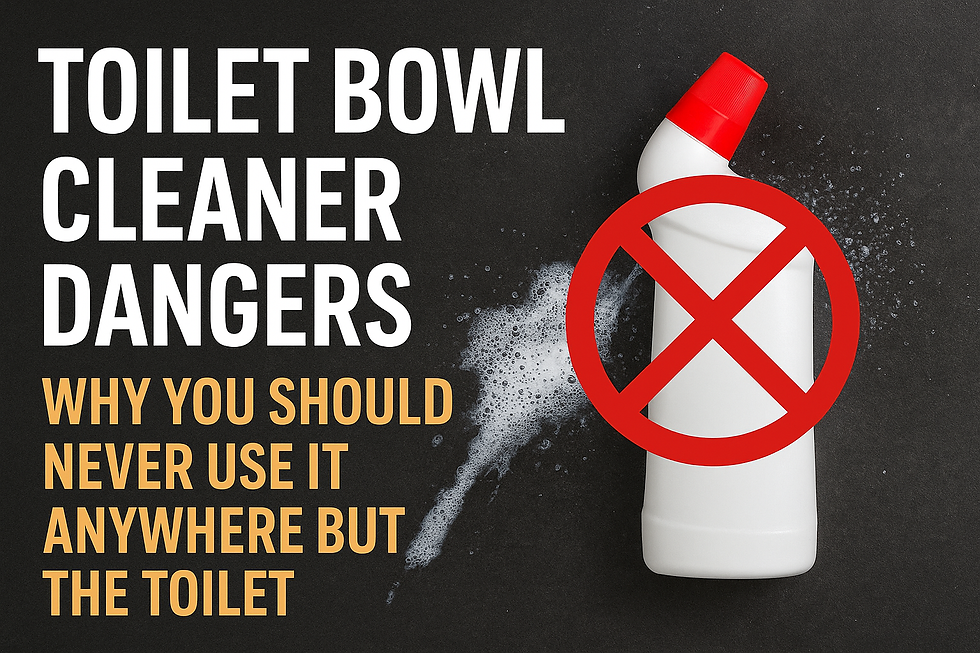5 Costly Mistakes of Using Toilet Bowl Cleaner on the Wrong Surfaces
- Deborah Shulman
- Oct 1
- 3 min read
I have been noticing these social media videos where so-called cleaners are using a toilet bowl cleaner on surfaces other than a toilet. Please do not do this. When it comes to cleaning, many of us grab whatever product is under the sink and hope it does the job. But did you know that using toilet bowl cleaner on surfaces other than your toilet can cause serious damage—and even put your health at risk? While these cleaners are designed to tackle one of the dirtiest spots in your home, they are far too harsh for most other areas. Here’s why you should keep the toilet bowl cleaner where it belongs: in the toilet only.

1. Highly Corrosive Ingredients
Toilet bowl cleaners are formulated with powerful acids, like hydrochloric acid or bleach, to break down tough stains, mineral deposits, and bacteria in your toilet. Those same ingredients can:
Etch countertops (especially stone surfaces like granite, marble, or quartz).
Strip finishes off sinks, tubs, and flooring.
Eat through metal fixtures like faucets and drains.
What works wonders on porcelain can leave permanent scars elsewhere.
2. Dangerous Chemical Reactions
Mixing toilet bowl cleaner with the wrong surface or substance can cause toxic fumes. For example, if it touches ammonia-based cleaners, it can release chloramine gas—a chemical that irritates the lungs, eyes, and throat. Spraying it onto surfaces in kitchens or laundry rooms could put your family at risk without even realizing it.
3. Health Risks from Residue
Unlike toilets, which flush away residue completely, other surfaces can hold onto cleaner long after you’ve wiped. This means chemicals can transfer onto your hands, food, or even your pets’ paws. The results? Skin irritation, accidental ingestion, or long-term exposure to toxic chemicals.
4. Ineffective on the Wrong Surfaces
Using toilet bowl cleaner on sinks, showers, or floors won’t make them any cleaner—it often does the opposite. The harsh formula isn’t designed for grease, soap scum, or dust. Instead of saving time, you’ll likely spend more time scrubbing off stains or repairing damage.
5. Real-Life Cleaning Horror Stories
Sometimes it helps to see just how bad things can get. Here are a few real-life stories of what happens when toilet bowl cleaner is used the wrong way:
The Bleached Bathtub Disaster: A homeowner poured toilet bowl cleaner around the edges of a porcelain bathtub to “deep clean.” Within minutes, the shiny finish began to dull. A week later, the tub had a rough, chalky texture that no amount of scrubbing could fix. They ended up paying over $500 to have it resurfaced.
Marble Countertop Mayhem: Someone tried to remove a coffee stain from a marble countertop with toilet bowl cleaner. The acid etched the stone instantly, leaving a permanent white ring. The only solution was replacing the entire slab—a costly $2,000 mistake.
The Rusted Faucet Fiasco: A renter thought toilet cleaner would “shine up” their bathroom sink faucet. Instead, it stripped the protective coating, causing the metal to corrode and rust within days. Their landlord charged them for the replacement.
The Breathing Scare: In one case, a person poured toilet bowl cleaner into a sink and then sprayed another product with ammonia to try to “boost the cleaning power.” The mix created toxic fumes that sent them coughing and gasping for air. They ended up in the ER with chemical inhalation.
6. Better Alternatives Exist
The good news is that every surface has a cleaning product that’s designed for it:
Sinks & Counters: Use an all-purpose cleaner or a mild disinfectant.
Tubs & Showers: A bathroom cleaner made for soap scum and mildew.
Floors: Gentle floor cleaners safe for tile, laminate, or hardwood.
Not only will you get a better clean, but you’ll also protect your home and family from unnecessary damage.
💡 Pro Tips: What to Do If You Spill Toilet Bowl Cleaner Elsewhere
Accidents happen! If you ever spill or accidentally apply toilet bowl cleaner somewhere you shouldn’t, here’s what to do right away:
Act Fast – Don’t let it sit. The longer it stays, the more damage it can do.
Rinse Immediately – Flush the area with lots of clean, cold water. For counters, tubs, or floors, wipe repeatedly with damp cloths.
Neutralize If Possible – For acidic cleaners, a light baking soda solution (water + baking soda) can help neutralize the acid.
Don’t Mix Other Chemicals – Never try to “counteract” it with another strong cleaner.This can make things worse.
Call a Pro for Surfaces Like Stone or Metal – Specialty surfaces like granite, marble, or stainless steel often need professional repair if etched or discolored.
Final Thoughts
Toilet bowl cleaner is a specialist product. It’s like using a chainsaw to trim your hedges—wrong tool, wrong results. Keep it in the bathroom, in the toilet only, and reach for the right cleaner for every other job.
Your home—and your health—will thank you!




Comments